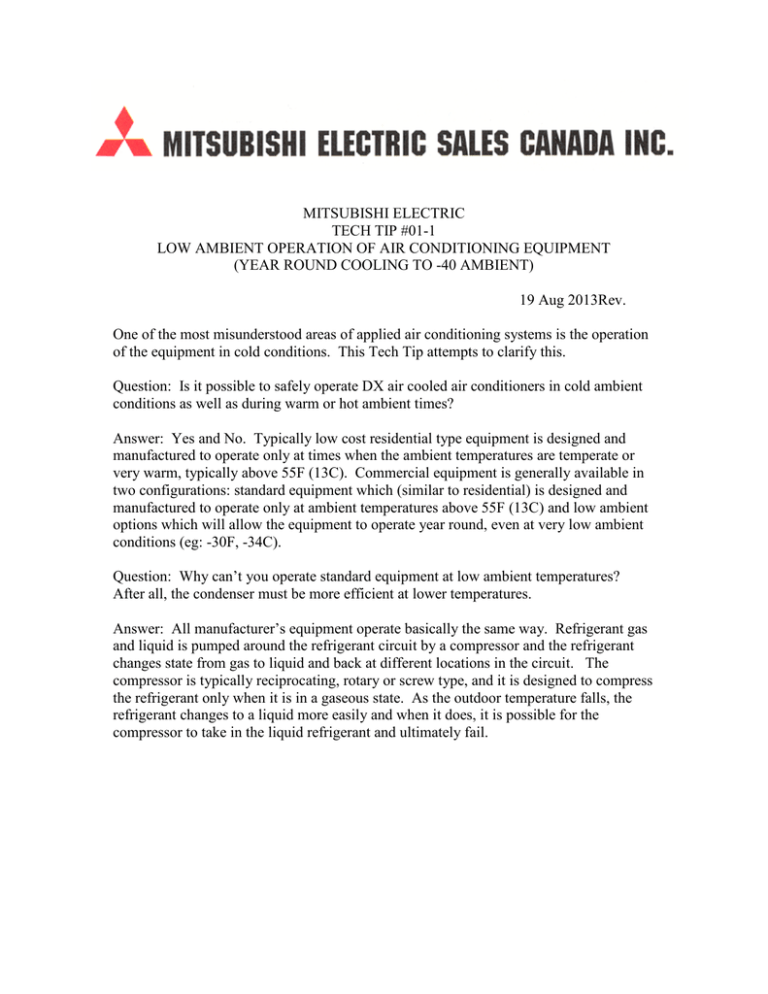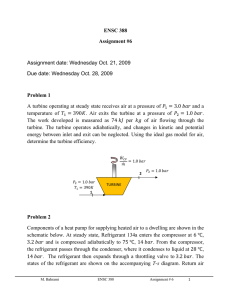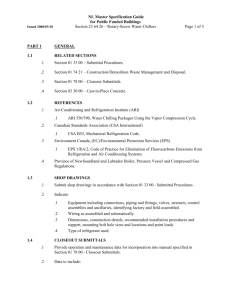mitsubishi electric tech tip #01-1 low ambient operation of air
advertisement

MITSUBISHI ELECTRIC TECH TIP #01-1 LOW AMBIENT OPERATION OF AIR CONDITIONING EQUIPMENT (YEAR ROUND COOLING TO -40 AMBIENT) 19 Aug 2013Rev. One of the most misunderstood areas of applied air conditioning systems is the operation of the equipment in cold conditions. This Tech Tip attempts to clarify this. Question: Is it possible to safely operate DX air cooled air conditioners in cold ambient conditions as well as during warm or hot ambient times? Answer: Yes and No. Typically low cost residential type equipment is designed and manufactured to operate only at times when the ambient temperatures are temperate or very warm, typically above 55F (13C). Commercial equipment is generally available in two configurations: standard equipment which (similar to residential) is designed and manufactured to operate only at ambient temperatures above 55F (13C) and low ambient options which will allow the equipment to operate year round, even at very low ambient conditions (eg: -30F, -34C). Question: Why can’t you operate standard equipment at low ambient temperatures? After all, the condenser must be more efficient at lower temperatures. Answer: All manufacturer’s equipment operate basically the same way. Refrigerant gas and liquid is pumped around the refrigerant circuit by a compressor and the refrigerant changes state from gas to liquid and back at different locations in the circuit. The compressor is typically reciprocating, rotary or screw type, and it is designed to compress the refrigerant only when it is in a gaseous state. As the outdoor temperature falls, the refrigerant changes to a liquid more easily and when it does, it is possible for the compressor to take in the liquid refrigerant and ultimately fail. Page 2 Question: What are the differences in equipment that allow operation during cold weather? Answer: There are a number of technologies with which to address the problem. In all cases, some form of supplemental heat must be applied in the refrigerant circuit in order to protect the compressor. This is particularly true with any system where the condenser is outdoors because when the system is shut down, the refrigerant will tend to migrate to the coldest point in the system where it is likely to become a liquid. Also, there must be some form of capacity control on the condenser itself because the coil (or heat exchanger) is selected to condense the refrigerant during the hottest day of the year and on colder days, the condenser is simply too large. One common way of accomplishing capacity control is by flooding the condenser coil with liquid refrigerant. In order to do this, it is common to use heaters and insulated jackets on the compressor along with an insulated, heated refrigerant receiver in the refrigerant circuit. The receiver must be sized for the system taking into account the size and length of the piping and components as well as the excess refrigerant required to flood the condenser coil. This combined with a head master control valve which controls the amount of liquid refrigerant in the condenser coil, will control the pressures and temperatures in the system during warm and cold weather. The refrigerant system charging including setting of pressures and temperatures is typically done in the field by the installing contractor. Question: Are there other ways of controlling the refrigeration system during cold weather? Answer: With the continuous development of microprocessor controls, there is more flexibility in controlling all systems. Mitsubishi Electric uses a microprocessor control system along with a very large heated and insulated suction accumulator. The accumulator is to store refrigerant and to prevent liquid refrigerant from passing to the compressor. Heaters and jackets are also provided for the compressor. On Mitsubishi R410A refrigerant units, the microprocessor controller via a variable frequency drive, controls the compressor speed to match the refrigerant flow required to the exact load while the condenser fans are controlled from zero to full speed as required. The microprocessor controller continually monitors refrigerant temperatures and pressures in the condenser and evaporator coils and when it recognizes low temperature operating conditions within the system, it provides further control by activating a defrost protection mode from time to time as required. The condenser fan motors are rated to run at low RPMs even at –40C. Page 3 Question: I’ve heard that a simple fan speed controllers can allow air conditioning equipment to operate at low ambient temperatures? Answer: Fan speed control can be used to control the condenser fans in response to varying loads. Often, these controls are added in the field by the installing contractor. On/Off fan speed control leads to erratic control performance with large swings in temperatures and pressures in the system, leading to shortened equipment life and danger of compressor damage. In general, this does not provide satisfactory performance in very low temperature conditions. In any event, the need to add heat to the system along with a heated storage reservoir for the refrigerant operating at low temperatures does not change. Since the compressor on many units is without safety controls, simply controlling condenser fan speed without additional control components will likely result in premature equipment failure. Manufacturer’s who use condenser fan speed control applied to standard condensers, typically rate these for operation to no lower than –20C. Standard condenser fan motors are not rated for low temperature operation and typically will not operate below 30% RPM at any temperature, meaning that at very low temperatures, control is not possible. Question: Are there any factory installed control systems available? Answer: Mitsubishi Electric provides literature about its factory installed low ambient systems, available as a standard option on all its “P” series commercial air conditioners. Mitsubishi “P” series air conditioners have been tested and the tests documented in cold weather conditions down to -40. This provides the customer with assurance that the equipment selected will operate in accordance with specifications. In Summary: It should be noted that not all “low ambient” rated equipment are created equal. Many manufacturers claim to have a “low ambient” option for their ductless split systems, but it is not factory installed and requires field modifications to the equipment. Even then, the system components may not be suitable for –40C to meet Canadian winter conditions. Most manufactures have not developed a true –40C low ambient condensing unit due to the relatively small world market for these products. Mitsubishi Electric has served the Canadian market for 34 years and realized early on, that this low ambient operating feature was required for many commercial applications. With many thousands of these units operating successfully, many in the coldest parts of Canada, only Mitsubishi ductless split systems have a proven track record of reliable operation in our harsh environmental conditions. Please contact us for a list of references. ADDENDUM - 1: Characteristics of Mitsubishi P Series equipment certified to -40 Ambient - Cooling Equipment is commercial grade designed to operate 24/7, not modified residential. (Typically residential equipment is designed to operate only seasonally.) Oversized accumulator or receiver Heated, insulated accumulator Factory charged with R410A for up to 100 ft. of refrigerant line Scroll compressor Multiple crankcase heaters on compressor Compressor control by VFD Condenser fans controlled by VFD P Series units factory tested in labs and in service in the Arctic to -40 Factory literature shows certification to -40 Shipping carton for each unit bears factory labeling for -40 operation Each unit bears factory label for -40 operation Condenser fan motors certified to operate to -40 Condenser fans operate full range 0 – 100% Front, rear and side wind blockers – Color matching Solid state electronic controls certified to -40 Fan speed control Louvre swing/directional control Low pressure protection Low temperature protection High pressure protection High temperature protection Defrost warning control Defrost control Auto restart Built in timer Filter change alert Metric/English units Multiple unit control Self diagnostics: - Display of all operating parameters (Pipe temperatures, electrical) - Compressor speed display - Operating hours display Optional Control Items: Auxiliary contacts to control supplemental heaters Remote alarm contacts Remote start stop control Remote status indication Compatible with select BMS systems – BacNet, LonWorks, PLC “I See” sensor – to direct heating/cooling air stream at load




